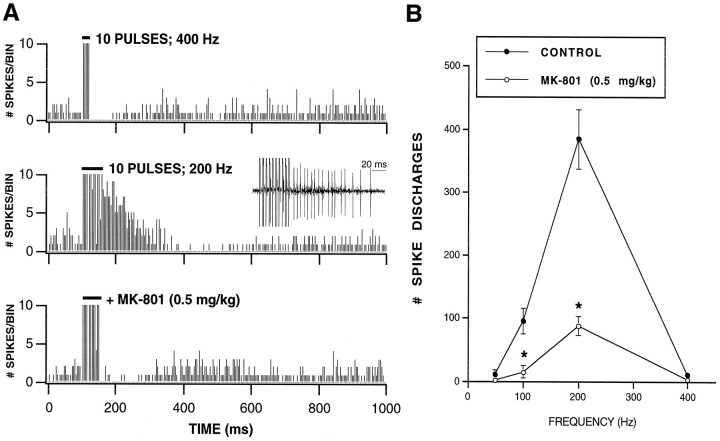Fig. 5.
Systemic administration of NMDA receptor antagonists attenuate frequency-dependent multiple spike discharges evoked by stimulation of cortical input to VTA nondopamine neurons.A, These peristimulus spike histograms demonstrate the effects of high-frequency stimulation of the IC on VTA non-DA spike discharges. Each histogram represents 10 cumulated epochs of IC stimulation (0.1 Hz; bin width, 2 msec). Stimulation of the IC with 10 pulses at 400 Hz did not evoke spike discharges but produced a 100 msec period of inhibition of spontaneous firing (top), whereas the same number of pulses at 200 Hz elicited multiple spike discharges that occurred with latencies nearly an order of magnitude greater than the single spike latency of 2–3 msec (middle). The inset shows a representative filtered recording of a VTA non-DA neuron after high-frequency stimulation (200 Hz; 10 pulses) of the IC. Systemic administration of the NMDA receptor antagonist MK-801 markedly suppressed the multiple discharging of this VTA non-DA neuron (bottom). The horizontal bar in each histogram represents the stimulus train. B, Summary of the VTA non-DA spike discharges produced by high-frequency IC stimulation shows that the number of spike discharges is a function of the frequency of stimuli. For all frequencies, the number of pulses and the number of epochs were held constant at 10 while varying the interval between pulses. Although 50 and 400 Hz evoked little or no spike discharges, 200 Hz markedly and 100 Hz moderately increased discharging. Systemic administration of MK-801 significantly reduced VTA non-DA spike discharging produced by IC stimulation across frequencies. Asterisks indicate significance level (p < 0.001).

